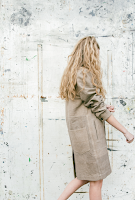Jennie Barck. Powered by Blogger.




 British streetwear label A-Cold-Wall creates unfinished, dirty looking and untidy everyday wear that takes the ideals of wabi sabi and combines them with a contemporary sensibility. The items look worn out and have been taped up with duct tape but still look desirable. Each piece is unique as they are hand dyed to all have a slightly varied finish. The garments are authentically individualistic and not trying to pull off a marketing trick; instead the designer wanted to showcase the touch of the maker.
British streetwear label A-Cold-Wall creates unfinished, dirty looking and untidy everyday wear that takes the ideals of wabi sabi and combines them with a contemporary sensibility. The items look worn out and have been taped up with duct tape but still look desirable. Each piece is unique as they are hand dyed to all have a slightly varied finish. The garments are authentically individualistic and not trying to pull off a marketing trick; instead the designer wanted to showcase the touch of the maker.

 Story MFG's garments are hand loomed, spun, weaved and dyed to create collections with an austere beauty. The pieces that may vary in their colouring and hand painted details, charm with their imperfections and make each piece a one of kind. Inspired by indian colours and textures, the collections focus and excel in denim but also range into other materials suitable for everyday wear. The brand has taken up production all around the world with different expertise sourced in their respective countries; Hand woven denim and Tahini dyeing in Thailand, laser printing in Valencia and Batik dyeing in India. All these crafts experts join together to create a tapestry of pure skill that combines into lasting, good quality clothing.
Story MFG's garments are hand loomed, spun, weaved and dyed to create collections with an austere beauty. The pieces that may vary in their colouring and hand painted details, charm with their imperfections and make each piece a one of kind. Inspired by indian colours and textures, the collections focus and excel in denim but also range into other materials suitable for everyday wear. The brand has taken up production all around the world with different expertise sourced in their respective countries; Hand woven denim and Tahini dyeing in Thailand, laser printing in Valencia and Batik dyeing in India. All these crafts experts join together to create a tapestry of pure skill that combines into lasting, good quality clothing. The Doen garments are hand woven, embroidered and knitted locally in California and overseas in India and Peru. The pieces have a raw and nostalgic feel with the vintage LA inspired look coveted by the women who owned and founded brand. It is about finding pieces that are comfortable and designed for women by women, in a way that doesn't have to be glamorous in a conventional sense, but finds beauty in nature. By reusing old styles and connecting that with a feminist agenda, the brand is elevating wabi sabi to the modern era.
The Doen garments are hand woven, embroidered and knitted locally in California and overseas in India and Peru. The pieces have a raw and nostalgic feel with the vintage LA inspired look coveted by the women who owned and founded brand. It is about finding pieces that are comfortable and designed for women by women, in a way that doesn't have to be glamorous in a conventional sense, but finds beauty in nature. By reusing old styles and connecting that with a feminist agenda, the brand is elevating wabi sabi to the modern era.
An honest website for a different kind of fashion folk